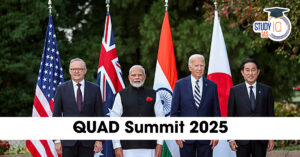Table of Contents
Exercise Vayu Shakti
Context: This Vayu-Shakti 2024 will be held in Pokhran firing range, Rajasthan.
About Exercise Vayu Shakti
- Showcases: IAF’s offensive and defensive capabilities
- Covers: Day and night operations
- Demonstrates:
- Long-range and precision weapon delivery
- Conventional weapon accuracy and effectiveness
- Multi-air base operations
- Highlights: Coordination and combined operations with the Indian Army.
| Facts |
| For the first time, the exercise will feature participation from Rafale fighter jets, along with Prachand and Apache attack helicopters, among other platforms. |
We’re now on WhatsApp. Click to Join
New Chief Justices appointed for 6 HCs
Context: Recently, the Union Ministry of Law and Justice notified the appointments of new Chief Justices (CJs) across six high courts (HCs).
Procedure for Appointment of Chief Justice of High Court
- Article 217 of the Constitution: The Chief Justices of High Courts are appointed by the President of India in consultation with the Chief Justice of India and the Governor of the State.
- Initiation of Proposal: The Chief Justice of India starts the appointment process for the Chief Justice of a High Court, ensuring it begins well ahead of the vacancy to complete it at least one month prior.
- Succession and Transfers: The Chief Justice of India must ensure the simultaneous appointment of successors when a Chief Justice is transferred, minimising the duration of acting Chief Justice appointments to no more than a month.
- Consultation Process: Recommendations for appointing a puisne Judge as Chief Justice are made after consulting the two senior-most Judges of the Supreme Court and any Judge familiar with the High Court’s affairs.
- Submission to Government: The Chief Justice of India’s recommendations are forwarded to the Union Minister of Law, Justice and Company Affairs.
- Government and Presidential Approval: The Union Minister consults the relevant State Government, then submits the proposals to the Prime Minister, who advises the President on the selection.
- Official Announcement: Following the President’s approval, the Department of Justice announces the appointment and issues a notification in the Gazette of India.
| Collegium For High Court |
|
Law Commission recommends retaining Criminal Defamation
Context: The 22nd Law Commission in its 285th Report has recommended that criminal defamation should be retained within the scheme of criminal laws in India.
| More In News |
|
About Law Commission
- Nature and Formation: The Law Commission of India is neither a constitutional body nor a statutory body, it is an executive body.
- However, it is not defined under the Indian Constitution. It is constituted as part of Article 39A.
- The Commission is established for a fixed tenure and works as an advisory body to the Ministry of Law and Justice.
- It is periodically constituted by the Government of India since its first establishment in 1955.
- History of Establishment:
- First Commission (Pre-independence):Formed before independence in 1834, was instituted by the British Government following the Charter Act of 1833, with Lord Macaulay serving as the chair.
- Post-Independence Establishment: The inaugural Law Commission of independent India was established in 1955, under the leadership of M.C. Setalvad.
- Successive Commissions: Since gaining independence, India has constituted a total of 22 Law Commissions.
- Functions:
- Identifying and recommending the repeal of outdated laws.
- Proposing new legislation to fulfill the Directive Principles of State Policy and Constitution’s Preamble.
- Providing opinions on legal and judicial matters referred by the Government through the Ministry of Law & Justice.
| Article 39A |
The state must:
|
About Defamation
- Definition of Defamation (Under Section 499 of Indian Penal Code): Defamation occurs when an individual’s reputation is harmed by another’s accusations, expressed through words, signs, or visible means, intending to tarnish their image.
- Types of Defamation: Civil and Criminal
- Civil Defamation: In cases of civil defamation, the aggrieved party can approach High Courts or lower courts to pursue monetary compensation for the damage to their reputation.
- Criminal Defamation (Section 500 of IPC): In criminal defamation cases, the accused may face up to two years in prison, a fine, or both as potential penalties.
Indian Navy foils Piracy attempt
Context: Indian warship INS Sharda rescued the vessel FV Omaril with 11 Iranian and eight Pakistani crew members off east coast of Somalia.
About INS Sharda
- INS Sharda (P55) is a Sukanya class patrol vessel of the Indian Navy.
- Built by: Hindustan Shipyard Limited.
- Launched: 22 August 1990
- Commissioned: 27 October 1991
- Operations: On 17 May 2017, the ship rescued a Liberian registered merchant vessel, MV Mountbatten, from pirates while on patrol in the gulf of Aden.
In recent years, waters off the west coast of Africa, Gulf of Aden, Horn of Africa, Bangladesh, and the Strait of Malacca have seen attacks by pirates.
| Why these areas and not elsewhere? |
|
Cruise vs Ballistic Missile
Context: North Korea continues its weapons testing, firing cruise missiles amidst escalating tensions and “war preparations” against South Korea.
Difference Between Cruise And Ballistic Missiles
| Aspect | Cruise Missile | Ballistic Missile |
| Flight Path | Low-level, terrain-hugging, within the atmosphere | High arcing, parabolic trajectory, exits and re-enters atmosphere |
| Propulsion | Jet engine, sustained propulsion throughout flight | Rocket boosters, propelled initially, coasts without propulsion mid-flight |
| Guidance Systems | Advanced guidance with GPS, inertial, TERCOM or image-based systems | Inertial, sometimes with star sighting or GPS, terminal phase guidance |
| Speed and Altitude | Generally subsonic or supersonic, flies at lower altitudes | Hypersonic speeds, reaches extremely high altitudes |
| Defensive Countermeasures | Hard to detect due to low altitude and potential for stealth technology | Easier to detect at launch, difficult interception due to speed and trajectory |
| Purpose and Use | Precision strikes against specific targets requiring controlled flight paths | Delivery of strategic payloads, including nuclear, across continents |
| Examples (India) | BrahMos, Nirbhay | Prithvi I, Prithvi II, Agni I, Agni II and Dhanush missiles. |
Water – Protecting the natural resource
Context: The UN 2023 World Water Development Report noted that 26 per cent of the world’s population does not have access to safe drinking water.
Water scarcity and its consequences
- Water scarcity is caused by overuse, climate change, population growth, and uneven distribution.
- 26% of the world’s population lacks safe drinking water.
- India is water-stressed, with only 4% of global water resources despite having 18% of the global population.
Water trading and the ethical debate
- The CME Group launched water futures contracts in 2020, raising concerns about commodification and affordability.
- The UN Special Rapporteur on water rights expressed concern about potential marginalisation of vulnerable groups.
Constitutional and legal framework in India
- Article 262 empowers Parliament to legislate on inter-state water disputes.
- The Inter-State Water Disputes Act, 1956, establishes tribunals to adjudicate such disputes (e.g., Cauvery water dispute).
- Supreme Court rulings recognize water as part of the right to life (Article 21) and a state duty (Article 21).
Water pricing and privatisation
- Water pricing is determined by states, with no central regulation.
- Article 39 mandates state policies to ensure equitable distribution of natural resources like water.
- Concerns exist about “water sector reforms” pushing privatisation and higher tariffs, potentially excluding vulnerable populations.
Conclusion
- Water as a basic human right and natural resource must be protected from becoming unaffordable due to trading or privatisation.
- Sustainable and equitable water access for all should be the guiding principle.


 SSC MTS Salary 2025, Check Highest Salar...
SSC MTS Salary 2025, Check Highest Salar...
 F-35 Fighter Jet Stranded in Kerala: Dis...
F-35 Fighter Jet Stranded in Kerala: Dis...
 Quad Summit 2025: Key Announcements, Str...
Quad Summit 2025: Key Announcements, Str...





















